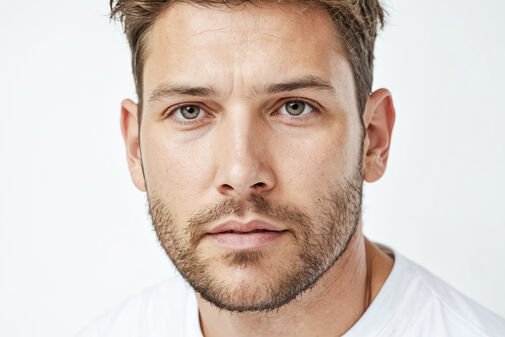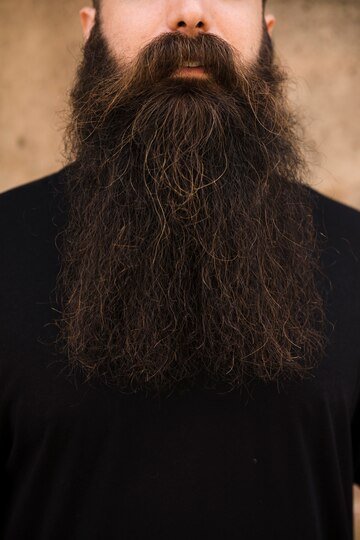A beard is a symbol of wisdom, masculinity, or style for men, and many men keep and grow them with pride. Almost all men want to keep their beards looking good and attractive. For a good and attractive look, the color of the beard works as a crucial factor. There are many men who color their beards even if they have naturally black hair. Well, there’s no problem with that. The problem arises when the color of their beard changes automatically with age.
Men find different colors in their beards, from black and brown to surprising hints of red and even grey. Many men become curious about these changes. They want to know the reasons for these changes and other details about them. To some, these changes can be fun, but they still raise questions. Why do they get red hair in their beard while their head hair isn’t red? Why are there grey hairs in their beard before they appear in their head? These changes in beard color are common for men, and there are several reasons for them.
In this blog, I will explain to you why our beard hair can change to different colors and what causes these changes. Whether you want to embrace your red or grey beard or want to keep the natural beard color, I will discuss this in detail. I will also share some tips on managing changes in your beard color.
Topics Covered
Toggle
Factors Influencing Hair Color
The color of our hair, including our beard, is influenced by several factors. Understanding these factors helps explain why we have such a wide variety of hair colors and why some people have unique combinations, like a red beard with brown hair. Let’s dive into the key factors that influence hair color: melanin, genetics, ethnicity, and other elements.
Melanin in Hair Pigmentation
We get our hair’s color from a pigment called Melanin. Melanin comes in two main forms: eumelanin and pheomelanin. Eumelanin is responsible for brown and black hair shades, while pheomelanin contributes to red and yellow (blonde) hair. The combination of these two pigments in each hair follicle determines the color of our hair. People with more eumelanin tend to have darker hair, while those with more pheomelanin have lighter or red hair.
Genetic Variations in Hair Color
Genetics play a big role in determining hair color. The MC1R gene, in particular, affects the type of melanin our body produces. Variations in this gene can lead to different hair colors, like red or ginger. This is why some people have red beards even if they don’t have red hair on their heads. Our genes, inherited from our parents, largely dictate these traits.
Ethnic Diversity in Hair Color
Ethnicity can influence hair color as well. Different ethnic groups tend to have different gene variations that affect hair color. For example, people of Irish or Dutch descent might be more likely to have red hair due to variations in the MC1R gene. Similarly, people of African or Asian descent often have more eumelanin, resulting in darker hair. The structure of hair also varies across ethnicities, affecting how color is perceived. Thicker hair strands, for example, can appear darker because they absorb more light.
Other Factors
Hair color can be influenced by variables other than genetics and ethnicity. Age and hormonal changes can cause hair to change color over time. Environmental factors, like sun exposure, can also affect pigmentation. Even stress might play a role in changing hair color, making it more varied as we age. These factors can add to the complexity and uniqueness of each person’s hair color.
How Beard Hair Can Differ from Head Hair
You might often notice that the hair on your head and in your beard varies significantly in appearance. This can be puzzling, but there are some key reasons why this happens. One major factor is that the hair follicles on your beard and scalp are not identical. They can react differently to hormones in your body. For example, androgens like testosterone have a significant impact on beard growth. These hormones can affect the color and texture of your beard hair differently than they affect your scalp hair.
Another reason for this difference is related to genetics. The genes that influence hair color can behave differently in various parts of your body. For instance, a genetic variation might cause your beard hair to be a different color from your head hair, even if both areas are influenced by the same hormones.
Additionally, the shape and type of hair follicles in your beard can be different from those on your head. Beard hair follicles are often more sensitive to hormonal changes, which can cause them to produce hair that is coarser or curlier compared to the smoother hair on your scalp. Your head hair and beard may have different textures and colors as a result of this.
Why Your Beard Might Be Red
You’re not alone if you’ve ever discovered red hairs in your beard, even if you’re not naturally redheaded. Many people experience this surprising color variation in their facial hair. There are a few key reasons why your beard might have red hues.

The main reason for a red beard is genetics. The MC1R gene, responsible for red hair, can influence your beard color. Even if you don’t have red hair on your head, a variation in the MC1R gene can cause your beard to produce more pheomelanin, the pigment responsible for red tones. This gene can be passed down from your parents or ancestors, which is why you might see red hairs even if no one in your immediate family has red hair.
Another reason for the reddish color in your beard is how different pigments mix. The two types of melanin that determine hair color are eumelanin and pheomelanin, as was previously mentioned. Eumelanin gives hair darker shades, like brown and black, while pheomelanin gives lighter, red tones. If your beard has a higher concentration of pheomelanin, it can appear red, even if your scalp hair is a different color.
The MC1R gene’s effect can vary, sometimes causing a completely red beard or just a few red strands among your other hair colors. This variation can occur in specific areas, like the mustache, sideburns, or chin.
Why Your Beard Might Be Gray
Finding gray hairs in your beard can be surprising, but it’s a natural part of aging for many people. The primary reason for a graying beard is genetics, which determines not only your hair type but also when it begins to lose its original color. Hair turns gray when the hair follicles stop producing pigment cells known as melanocytes, which create your natural hair color. Gray or white hair is caused by a decline in the development of these pigment cells as you age.

Genetics can offer clues about when you might start to see gray in your beard. If your parents began to gray early, there’s a good chance you might follow a similar pattern. However, other factors can also influence the graying process. Nutritional deficiencies, such as a lack of essential vitamins and minerals, might speed up graying. Lifestyle choices like smoking and stress can contribute to premature graying as well. Additionally, excessive sun exposure can weaken hair, and using harsh chemical products might interfere with melanin production, further accelerating the appearance of gray hairs.
Will Red Beards Eventually Turn Grey?
Red beards, known for their distinctive and vibrant color, hold onto their natural pigment longer than other hair colors. This is because the pigment responsible for red hair, known as melanin, tends to fade more slowly over time. However, as with all hair colors, the natural aging process eventually leads to a decrease in melanin production, resulting in gray hairs.
While red hair transitions through various shades like auburn and copper before turning gray, it doesn’t make red beards immune to the effects of aging. Factors such as genetics and hormone levels, like testosterone, can influence how quickly these changes occur. Interestingly, some people might notice their beards turning gray before the hair on their heads due to these hormonal differences.
Even though a red beard may take longer to show signs of graying, it will eventually do so. Embracing the natural shift to a salt-and-pepper look can be a stylish and confident choice, as many find gray beards to be distinguished and appealing. Remember, aging is a natural part of life, and your beard can still look great as it transitions through its unique phases.
How to Manage a Red or Grey Beard
Having a red or gray beard is like wearing a badge of uniqueness and experience. Genetics plays a major role in determining beard color, resulting in a rich variety of hues from vibrant reds to sophisticated grays. Embracing this individuality can be a source of pride, but it also comes with its own set of care needs to keep the beard looking its best. Caring for a red or grey beard involves understanding its unique needs and taking steps to keep it looking its best. Both red and grey beards have their charm, and with the right care, they can look healthy and stylish.
Regular Cleaning
Keep your beard clean by washing it regularly with a gentle beard wash. This removes dirt, oil, and dead skin cells without stripping away natural oils, helping your beard look fresh and healthy.
Moisturize and Condition
Keeping your beard and the skin underneath moisturized is key. Use a good beard oil or moisturizer to prevent dryness, reduce itchiness, and keep your beard soft. This is especially important for grey beards, which can be coarser.
Nourishing Oils
Applying beard oil can add shine and softness, making your beard more manageable and less prone to breakage. Choose oils that suit your beard type, whether it’s red or grey, to enhance its natural color and texture.
Trim Regularly
Regular beard trims can keep your beard in form and eliminate split ends, even if you’re growing it out. This maintains your facial hair neat and styled.
Balanced Diet
A diet rich in essential nutrients like Vitamin B12, iron, and zinc supports healthy hair growth and pigmentation. To maintain the vibrancy of your beard, incorporate leafy greens, salmon, eggs, nuts, and full grains into your diet.
Stress Management
High stress can affect your overall health, including your hair. Practice relaxation techniques like meditation or exercise to keep stress levels in check.
Sun Protection
Protect your beard from excessive sun exposure, which can cause damage. For your beard’s safety, use sunscreen or beard care products with UV protection.
Embrace or Enhance Your Look
As your beard turns grey, you can choose to embrace the distinguished look it offers or use natural dyes to maintain its color. Either way, owning your unique style is what matters most.
Managing a red or grey beard is about celebrating its uniqueness while taking care of its health. With the right routine, you can confidently rock your beard, whether it’s fiery red or a sophisticated grey.



